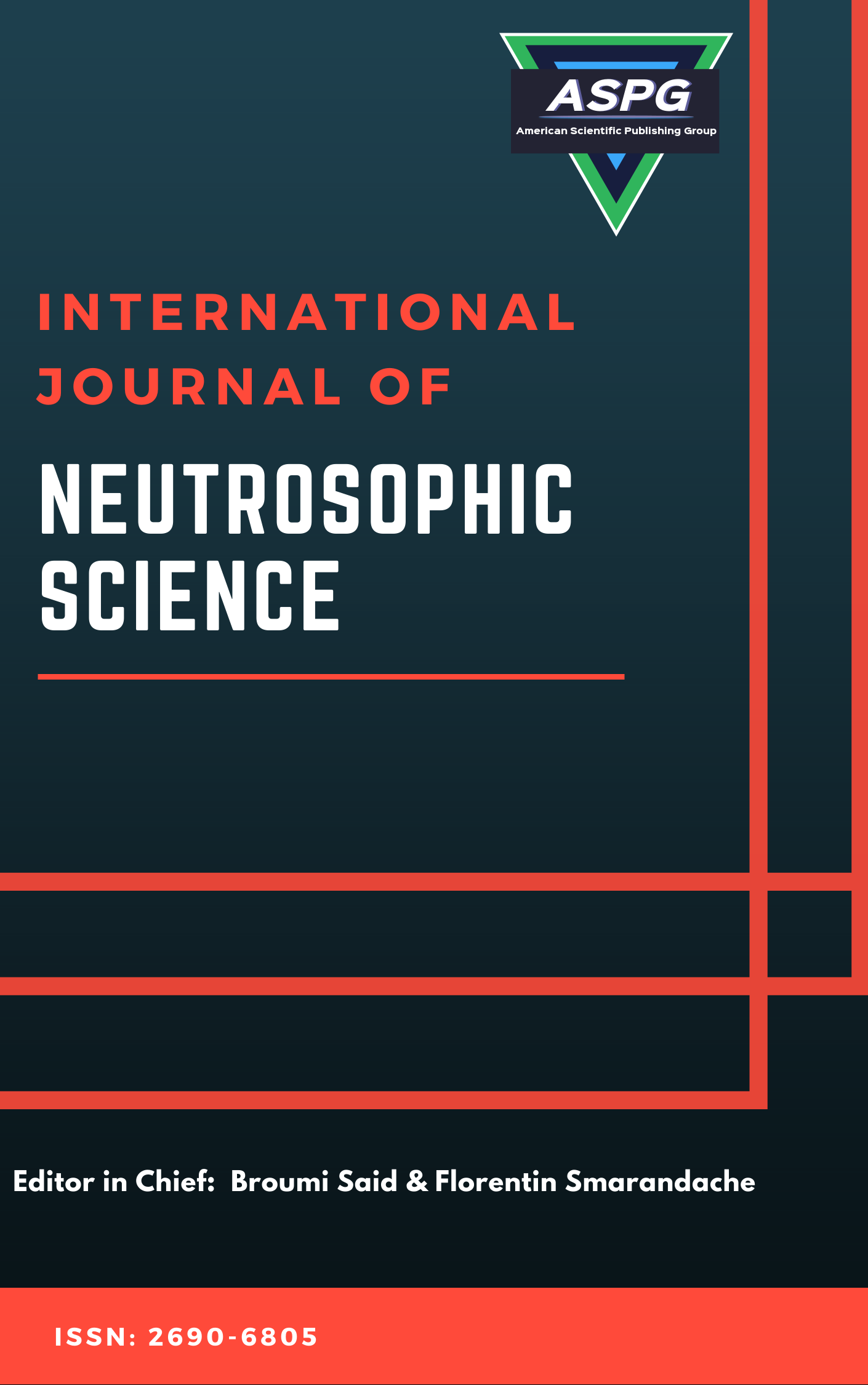

Volume 26 , Issue 2 , PP: 204-214, 2025 | Cite this article as | XML | Html | PDF | Full Length Article
Elvir Akhmetshin 1 * , Ilyos Abdullayev 2 , Aleksey Ilyin 3 , Denis Shakhov 4 , Tatyana Khorolskaya 5
Doi: https://doi.org/10.54216/IJNS.260215
A neutrosophic set (NS) contains 3 modules such as the degree of truth (T), degree of falsity (F), and degree of indeterminacy (I). While fuzzy graphs (FG) occasionally fall short of providing optimum outcomes, the NS and neutrosophic graphs (NG) provide a strong substitute, which efficiently handles the uncertainties related to indeterminate and inconsistent data in real-life scenarios. Conversely, bipolar neutrosophic methods, which account for both negative and positive effects, deliver a more flexible and applicable technique. Financial crisis prediction (FCP) is inherent in the detection of major social and economic impacts that crises of financial might hold on a global measure. It generally outcomes in vast financial losses, redundancy, and losses in values of assets that lead to significantly affected individuals and businesses. In recent times, the credit risk prediction methods have aided businesses in resolving whether to award credit to users who applied. This paper presents the Financial Credit Risk Forecasting Using Bipolar Single-Valued Neutrosophic Graph Sets Approach (FCRF-BSVNGSA) method. The main intention of the FCRF-BSVNGSA method is to develop an effective method for financial credit risk prediction using advanced methods. At first, the data normalization stage utilizes Z-score normalization for converting the input data into a beneficial format. Furthermore, for the financial credit risk classification process, the proposed FCRF-BSVNGSA model employs the bipolar single-valued neutrosophic graphs (BSVNG) approach. Finally, the multi‐objective hippopotamus optimization (MOHO) approach fine-tunes the hyperparameter values of the BSVNG model optimally and results in superior classification performance. An extensive simulation of the FCRF-BSVNGSA approach is performed under the Statlog (German Credit Data) dataset. The experimental validation of the FCRF-BSVNGSA approach portrayed a superior accuracy value of 95.59% over exisitng techniques.
Financial Credit Risk Forecasting , Data Normalization , Fuzzy Graphs , Bipolar Neutrosophic Set , Single-Valued Neutrosophic Graph
[1] R. Smith and T. Brown, "A novel approach to fuzzy logic-based risk assessment in finance," Expert Systems with Applications, vol. 167, p. 114301, 2021.
[2] J. P. Zhang and M. L. Chen, "A comparative study of machine learning algorithms for financial fraud detection," IEEE Access, vol. 9, pp. 67825-67835, 2021.
[3] A. D. Patel, K. Sharma, and B. Roy, "Optimization techniques in financial forecasting: A hybrid machine learning model," Applied Soft Computing, vol. 102, p. 107121, 2022.
[4] Y. Wang, J. Liu, and X. Zhao, "Sentiment analysis in financial decision-making using deep learning," Journal of Computational Science, vol. 52, p. 101437, 2022.
[5] M. T. Hassan, R. A. Khan, and A. Yousaf, "Credit risk evaluation using ensemble learning techniques," Journal of Banking & Finance, vol. 135, p. 106378, 2023.
[6] Y. Zhu, L. Zhou, C. Xie, G. J. Wang, and T. V. Nguyen, "Forecasting SMEs' credit risk in supply chain finance with an enhanced hybrid ensemble machine learning approach," International Journal of Production Economics, vol. 211, pp. 22-33, 2019.
[7] M. R. Machado and S. Karray, "Assessing credit risk of commercial customers using hybrid machine learning algorithms," Expert Systems with Applications, vol. 200, p. 116889, 2022.
[8] X. Ma and S. Lv, "Financial credit risk prediction in internet finance driven by machine learning," Neural Computing and Applications, vol. 31, no. 12, pp. 8359-8367, 2019.
[9] J. Duan, "Financial system modeling using deep neural networks (DNNs) for effective risk assessment and prediction," Journal of the Franklin Institute, vol. 356, no. 8, pp. 4716-4731, 2019.
[10] L. Gomez and P. Rodriguez, "Blockchain-based risk assessment models in financial applications," Computers & Security, vol. 120, p. 103445, 2022.
[11] L. Ji and S. Li, "A Dynamic Financial Risk Prediction System for Enterprises Based on Gradient Boosting Decision Tree Algorithm," Systems and Soft Computing, p. 200189, 2025.
[12] Y. Cui and F. Yao, "Integrating deep learning and reinforcement learning for enhanced financial risk forecasting in supply chain management," Journal of the Knowledge Economy, pp. 1-20, 2024.
[13] K. F. Mojdehi, B. Amiri, and A. Haddadi, "A novel hybrid Model for Credit Risk Assessment of Supply Chain Finance based on Topological Data Analysis and Graph Neural Network," IEEE Access, 2025.
[14] V. Amarnadh and N. R. Moparthi, "Prediction and assessment of credit risk using an adaptive Binarized spiking marine predators’ neural network in financial sector," Multimedia Tools and Applications, vol. 83, no. 16, pp. 48761-48797, 2024.
[15] A. Alamsyah, A. A. Hafidh, and A. D. Mulya, "Innovative Credit Risk Assessment: Leveraging Social Media Data for Inclusive Credit Scoring in Indonesia’s Fintech Sector," Journal of Risk and Financial Management, vol. 18, no. 2, p. 74, 2025.
[16] L. Zhang and L. Wang, "An Ensemble Learning-Enhanced Smart Prediction Model for Financial Credit Risks," Journal of Circuits, Systems and Computers, vol. 33, no. 7, p. 2450129, 2024.
[17] S. Mandala, W. Jatmiko, S. Nurmaini, and A. Rizal, "OCADN: Improving Accuracy in Multi-class Arrhythmia Detection from ECG Signals with a Hyperparameter-Optimized CNN," IEEE Access, 2025.
[18] S. N. F. Mohamad, R. Hasni, and B. Yusoff, "On dominating energy in bipolar single-valued neutrosophic graph," Neutrosophic Sets and Systems, vol. 56, no. 1, p. 10, 2023.
[19] G. G. Tejani, S. K. Sharma, N. Mashru, P. Patel, and P. Jangir, "Optimization of truss structures with two archive-boosted MOHO algorithm," Alexandria Engineering Journal, vol. 120, pp. 296-317, 2025.
[20] "Statlog (German Credit Data)," UCI Machine Learning Repository, [Online]. Available: https://archive.ics.uci.edu/ml/datasets/statlog+(german+credit+data). [Accessed: 27-Feb-2025].
[21] I. Katib, F. Y. Assiri, T. Althaqafi, Z. M. AlKubaisy, D. Hamed, and M. Ragab, "Hybrid hunter–prey optimization with deep learning-based fintech for predicting financial crises in the economy and society," Electronics, vol. 12, no. 16, p. 3429, 2023.